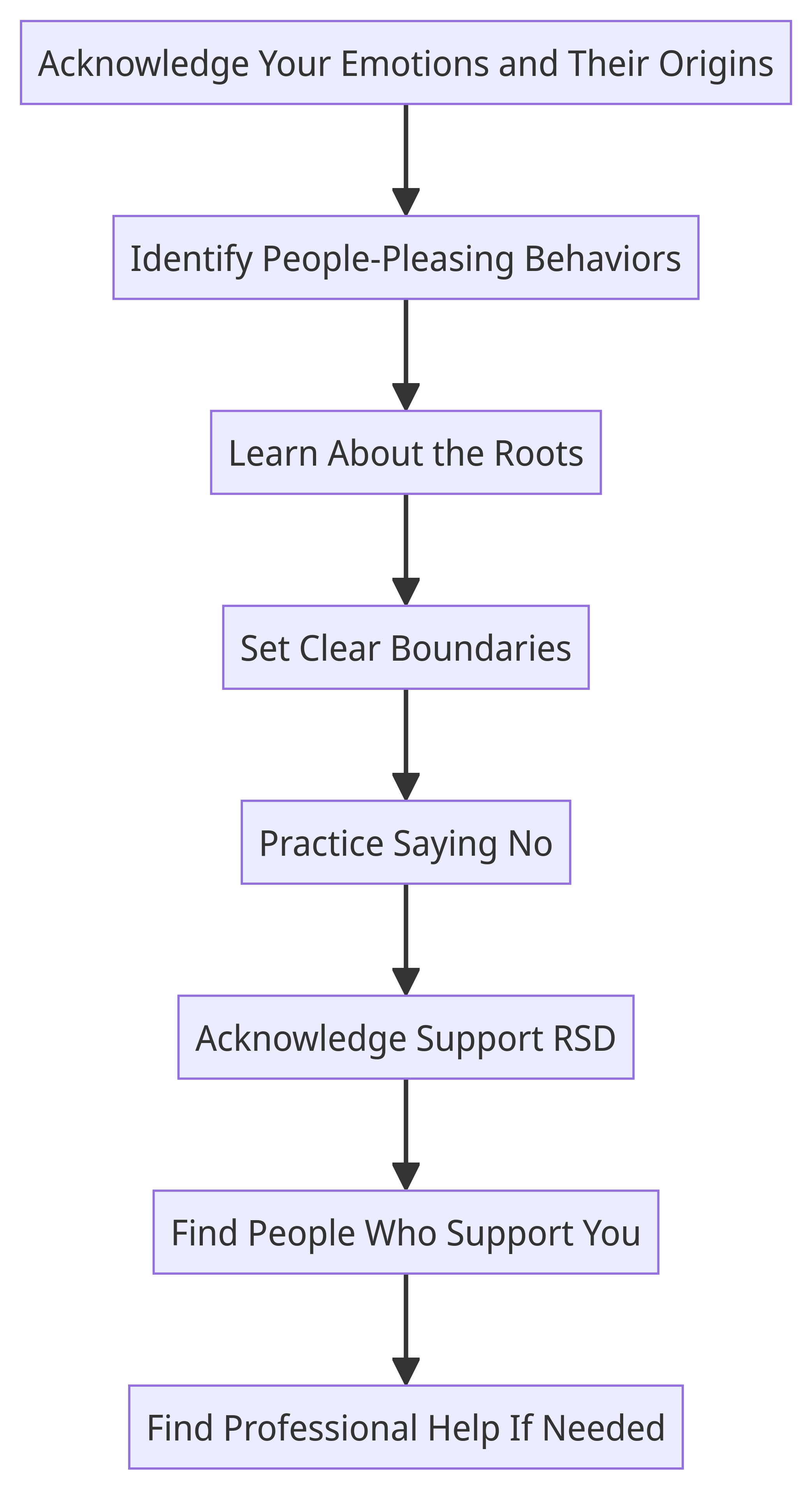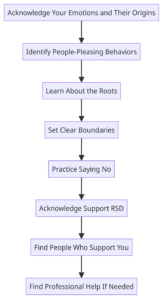

Introduction
Women with ADHD need to stop people-pleasing because it eventually leads to anger, resentment, burnout, and stress
However, late diagnosis, unrealistic expectations, and intense emotional responses such as guilt and shame, as well as fear of criticism and rejection sensitivity, can often lead to people-pleasing behaviors as a coping mechanism that's hard to let go of.
This guide provides a structured approach to help ADHD women stop people-pleasing and recognize and overcome these patterns, empowering them to prioritize their needs.
Step 1: Acknowledge Your Emotions- and Their Origin
Recognize the strong emotions like guilt, shame, fear, and anger that you experience more—understanding these emotions and society's role in causing you to feel them by mistreating you.
Step 2: Identify People-Pleasing Behaviors
Reflect on your recent interactions. Note instances where you agreed to something against your wishes or felt uncomfortable because you couldn't say no. Identifying these patterns is crucial for change.
Step 3: Learn About the Roots of People-Pleasing
Understand that people-pleasing often stems from an intense fear of rejection and a desire to be liked. This can be more pronounced in ADHD women due to damaging past experiences and trauma caused by lack of support and discrimination.
Step 4: Decide Upon and Set the Boundary.
Determine what you are and aren’t willing to accept in relationships and obligations. Define these boundaries clearly to yourself first, and then communicate them to others as needed.
Example of Setting Clear Personal Boundaries
Situation: Imagine a woman with ADHD named Sarah. She has a demanding job and also juggles various family responsibilities. Her friend often asks her for last-minute favors, like picking up her children from school or helping with emergency errands. While Sarah wants to be helpful, these last-minute requests add significant stress and disruption to her own tightly scheduled day, which she needs to manage her ADHD effectively.
Step 1: Define Personal Boundaries Sarah decides that to manage her time and stress levels better, she needs to limit last-minute favors. She defines her boundary: No last-minute requests unless it's a true emergency. She also decides that she will not accept any requests that are made with less than 24 hours’ notice, unless it involves a serious situation.
Step 2: Communicate Boundaries Clearly Sarah needs to communicate this boundary to her friend. She chooses a calm moment when there is no immediate request pending to talk about her decision. She explains that while she values helping her friend and cherishes their relationship, her tight schedule makes it difficult to accommodate last-minute favors. She expresses that this change is necessary for her to manage her own responsibilities and stress.
Step Conversation Example:
Sarah might say, "I really value our friendship and love being able to help out when I can. However, my schedule is usually very tight because of work and family, and I find it really stressful to handle unexpected tasks. I’d appreciate it if we could limit the last-minute favors. If you know you'll need help, I would be grateful if you could give me at least a day's notice. Of course, if there's an actual emergency, I'll do everything I can to be there for you."
Step 3: Enforce the Boundary After setting this boundary, it’s important for Sarah to stick to it. If her friend forgets and makes another last-minute request, Sarah can gently remind her of their agreement.
For example, she might say, "I remember we talked about last-minute requests being tough for me. I can’t make it today, but let’s see how else we can solve this."
Step 4: Adjust as Necessary Boundaries might need adjustment based on how they're working out. If Sarah finds her initial boundary too strict or too lenient, she can reassess and communicate any changes needed.
Summary
Setting boundaries like Sarah did involves recognizing what you can and cannot handle, clearly defining these limits, communicating them in a straightforward and respectful manner, and being consistent in maintaining them. This helps to manage stress and makes interpersonal relationships healthier and more sustainable, especially for someone managing ADHD.
Step 5: Practice Saying "No" Regularly To Stop People Pleasing
Begin with small, non-critical requests. Practice saying no when the stakes are low to build your confidence. Gradually, apply this to more significant decisions.
Example 1: Non-Critical Social Requests
Situation: Your colleague asks if you want to join a few coworkers for lunch. While you enjoy their company, you had planned to use your lunch break to relax and read your book today.
How to Say No:
-
Response: "Thanks for the invite! I actually brought a book I've been excited to start, so I'm going to take some alone time today. Enjoy your lunch, and I'll catch up with you all another day!"
This response is polite and appreciative, yet firm in your decision. It allows you to honor your original plan without feeling pressured to join.
Example 2: Minor Favors
Situation: A friend texts you last minute, asking if you can help them move some furniture this weekend. You already feel stretched thin and need the weekend to recharge.
How to Say No:
-
Response: "I wish I could help out, but I really need to take this weekend to recharge. I hope you understand. Good luck with the move, and let me know how it goes!"
Here, you acknowledge the request and express your inability to help in a caring way. It’s straightforward, explaining your need for rest without over-justifying.
Example 3: Work-Related Requests
Situation: Your boss asks you to take on an extra project, but you are already managing your maximum workload.
How to Say No:
-
Response: "I appreciate you considering me for this project. However, I am currently at capacity with my current assignments and want to ensure I maintain the quality of my work. Can werevisit this once I’ve wrapped up one of my other projects?"
This professional response communicates your current workload limits and your dedication to maintaining quality, suggesting a potential future discussion when you have more capacity.
Example 4: Community or Volunteer Commitments
Situation: You're asked to volunteer for an event at your child’s school this weekend, but you had planned that time for a personal commitment.
How to Say No:
-
Response: "Thank you for thinking of me for the event. I have prior commitments this weekend that I cannot reschedule. I hope the event goes well, and please keep me in mind for future opportunities."
This lets the other party know you are generally interested in participating, just not available at this time, and keeps the door open for future involvement.
Example 5: Persistent Requests
Situation: A friend repeatedly asks you to join a weekly book club, but you're not interested in committing to a weekly activity.
How to Say No:
-
Response: "I've given it some thought, and I don't think I can commit to a weekly book club right now. I appreciate your enthusiasm, and it sounds like a great group! I need to keep my evenings more open for now."
With this response, you’re clear about your decision, and by focusing on your need to keep schedules open, you avoid any implication that you might change your mind soon.
Summary
Starting with these smaller, less critical scenarios helps build the habit and confidence to say no. As you get more comfortable with these situations, you'll find it easier to maintain your boundaries in more significant or high-stakes circumstances. Each "no" reinforces your ability to prioritize your needs and manage your time and energy more effectively.
Step 6: Develop Coping Strategies for Rejection Sensitivity
Work on strategies to handle criticism and rejection without internalizing it. Techniques could include mindfulness, creating a sense of safety when you feel triggered, medicationor discussing feelings with a trusted friend or therapist.
Step 7: Establish a Support System
Build a network of friends, family, or support groups who understand ADHD allow you to use your strengths and unmask and can provide encouragement and accountability as you work on reducing your people-pleasing behaviors.
Step 8: Seek Professional Guidance
Professional therapy can be highly beneficial. A therapist familiar with ADHD can help you navigate your emotions, develop personal strategies, and reinforce your journey towards less people-pleasing and more self-reinvestment.
Conclusion
Each step is designed to help you gain more control over your life and decrease the need to please others at your expense. By following these steps, you can build a more authentic and satisfying life, characterized by healthier relationships and a stronger sense of self.
Note: Consistent professional support is often key in making sustainable changes, especially for those managing ADHD.
Kristen McClure: Neurodivergent-Affirming ADHD Therapist and Coach with 30 years experience in North Carolina and South Carolina Offering virtual therapy and coaching services across North Carolina, including Ashville, Raleigh, Durham, Wilmington, Greenville, and more. Also serving major South Carolina cities such as Charleston, Columbia, Greenville, Spartanburg, Rock Hill, and more.


